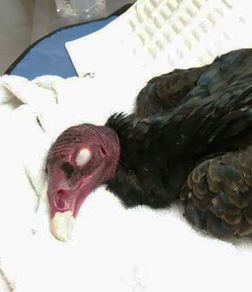
This Turkey Vulture represented a medical mystery worthy of prime-time television.
He arrived at the Wildlife Hospital utterly unresponsive. Comatose. He lay prostrate on the medical exam table, with no reflexes. When Medical Staff checked his eyes, his pupils were fixed and dilated. The photo to the right shows the out-cold bird, with his white lower eyelid covering his eye. In every way he appeared nearly dead.
And yet his vital signs, his heartbeat and breathing, were strong. This bird was alive, but nothing Medical Staff did could revive him.
A few other symptoms further complicated the mystery of this bird's illness. There was an abrasion, or burn on the exterior of his crop, and abrasions on his wings. His crop was very full, and over the course of emergency medical treatment, it got fuller, indicating that the contents of his stomach were coming back up.
To top it all, the bird's crop and mouth were full of a revolting brown mush, incredibly smelly and of a texture never before seen by Medical Staff.
Obviously they were going to have to help this Turkey Vulture vomit.
But first he needed some emergency medical treatment, including subcutaneous fluids, heat and oxygen. He was also given antidotes for poisoning, including Vitamin K, which counteracts the deadly effects of anticoagulant poisons, and Atropine which can reverse the effects of organophosphate poisoning. The bird was placed on oxygen for a period of time to rest, in hopes he would revive.
After an hour of this intensive care, the bird's condition didn't change, but his crop had gotten much larger, indicating that the contents of the vulture's stomach were coming back up. The bird needed to vomit, but in his condition he was unable to do so on his own.
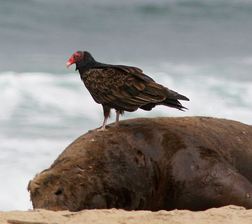 As you can imagine, a Turkey Vulture's vomit reaches a whole new level of disgusting due to his diet. These birds are absolutely integral to the health of our ecosystem because they eat carrion, dead things, in all stages of decomposition. Medical Staff suspected that the bird had eaten a dead poisoned animal and gotten poisoned himself, leading to his symptoms.
As you can imagine, a Turkey Vulture's vomit reaches a whole new level of disgusting due to his diet. These birds are absolutely integral to the health of our ecosystem because they eat carrion, dead things, in all stages of decomposition. Medical Staff suspected that the bird had eaten a dead poisoned animal and gotten poisoned himself, leading to his symptoms.
The developing situation required aggressive treatment, so WildCare's Director of Animal Care, Melanie Piazza and one of our Wildlife Interns donned gloves and face masks and, no doubt holding their breath, leaned the bird over a catch basin. Then Melanie reached her hand into the vulture's mouth and into his crop, taking precautions to avoid the bird's glottis so prevent him from choking.
We won't ruin your appetite by describing what came out, but its texture and appearance, aside from being completely revolting, was unusual, further confirming Melanie's suspicions that this bird had been poisoned.
When the entire contents of the bird's crop had been evacuated, he was given more fluids and returned to the oxygen incubator and monitored regularly. Medical Staff knew they had done all they could do to help this bird survive; the rest was up to him.
The next morning, when Melanie asked an opening-shift volunteer if the Turkey Vulture had survived the night, she was told he had not. The volunteer had seen the bird lying in the incubator, looking exactly as dead as he had the night before. She assumed he had expired. Melanie wasn't surprised but felt sad that the bird hadn't recovered.
Imagine the volunteer's surprise when she opened the incubator to find the lifeless-looking bird was still breathing! She came running back, saying he was actually still alive. Melanie brought the limp bird into the Med Room and rechecked his vitals. Although the bird was still completely unresponsive, his heartbeat was strong, and when she checked his eyes for a pupillary response, the pupils dilated slightly, if erratically, in response to the light. Despite still being comatose, the bird had actually improved!
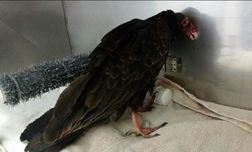 Over the next two days, Medical Staff thought the bird would die multiple times, but with continued supportive care they saw incremental improvements that kept them hopeful. On Wednesday of the same week, to everyone's surprise, the bird was actually standing on his own two feet in the incubator! He still had little control of his head and neck, and could only stand upright by bracing himself against the side of his enclosure, but the improvement was still significant.
Over the next two days, Medical Staff thought the bird would die multiple times, but with continued supportive care they saw incremental improvements that kept them hopeful. On Wednesday of the same week, to everyone's surprise, the bird was actually standing on his own two feet in the incubator! He still had little control of his head and neck, and could only stand upright by bracing himself against the side of his enclosure, but the improvement was still significant.
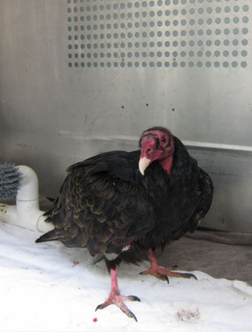 Slowly, the bird regained control of his body. In another couple of days, he was able to hold his own head up, and even to eat. He continued to improve over the next several days and in a surprisingly short amount of time, he was strong enough to be transferred to our large flight aviary to rebuild his strength. After a couple of weeks, this vulture was ready for release.
Slowly, the bird regained control of his body. In another couple of days, he was able to hold his own head up, and even to eat. He continued to improve over the next several days and in a surprisingly short amount of time, he was strong enough to be transferred to our large flight aviary to rebuild his strength. After a couple of weeks, this vulture was ready for release.
We took him to an open space area in his home territory and set him free-- cheering him on as he soared into the blue sky to circle with other Turkey Vultures that had flown in, we like to think, to welcome him home.
So what caused this bird's bizarre illness? Medical Staff's strong suspicion is secondary rodenticide poisoning from eating a poisoned rodent.
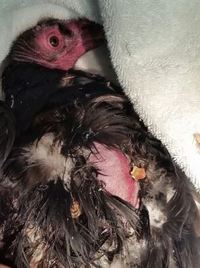 Not long after this bird's intake, another Turkey Vulture from an unrelated area arrived at WildCare with less-severe versions of the exact same symptoms! This bird also had the brown mush in his mouth, and the abrasions on his crop and wings. Medical Staff hypothesizes that, at the moment the poison hit these birds' systems, they crash-landed, scraping along the ground on their full crops and the edges of their wings, which caused these injuries.
Not long after this bird's intake, another Turkey Vulture from an unrelated area arrived at WildCare with less-severe versions of the exact same symptoms! This bird also had the brown mush in his mouth, and the abrasions on his crop and wings. Medical Staff hypothesizes that, at the moment the poison hit these birds' systems, they crash-landed, scraping along the ground on their full crops and the edges of their wings, which caused these injuries.
In the photo to the right, note the angry red line on the exposed skin of the bird's chest. This naked skin is the crop, and the red line is the abrasion or burn.
Medical Staff also induced vomiting in this patient, and treated him for exposure to poison with Vitamin K and Atropine. He also survived, and is recovering at WildCare. We expect him to be able to be released soon.
Support HuffPost
Our 2024 Coverage Needs You
Your Loyalty Means The World To Us
At HuffPost, we believe that everyone needs high-quality journalism, but we understand that not everyone can afford to pay for expensive news subscriptions. That is why we are committed to providing deeply reported, carefully fact-checked news that is freely accessible to everyone.
Whether you come to HuffPost for updates on the 2024 presidential race, hard-hitting investigations into critical issues facing our country today, or trending stories that make you laugh, we appreciate you. The truth is, news costs money to produce, and we are proud that we have never put our stories behind an expensive paywall.
Would you join us to help keep our stories free for all? Your contribution of as little as $2 will go a long way.
Can't afford to donate? Support HuffPost by creating a free account and log in while you read.
As Americans head to the polls in 2024, the very future of our country is at stake. At HuffPost, we believe that a free press is critical to creating well-informed voters. That's why our journalism is free for everyone, even though other newsrooms retreat behind expensive paywalls.
Our journalists will continue to cover the twists and turns during this historic presidential election. With your help, we'll bring you hard-hitting investigations, well-researched analysis and timely takes you can't find elsewhere. Reporting in this current political climate is a responsibility we do not take lightly, and we thank you for your support.
Contribute as little as $2 to keep our news free for all.
Can't afford to donate? Support HuffPost by creating a free account and log in while you read.
Dear HuffPost Reader
Thank you for your past contribution to HuffPost. We are sincerely grateful for readers like you who help us ensure that we can keep our journalism free for everyone.
The stakes are high this year, and our 2024 coverage could use continued support. Would you consider becoming a regular HuffPost contributor?
Dear HuffPost Reader
Thank you for your past contribution to HuffPost. We are sincerely grateful for readers like you who help us ensure that we can keep our journalism free for everyone.
The stakes are high this year, and our 2024 coverage could use continued support. If circumstances have changed since you last contributed, we hope you’ll consider contributing to HuffPost once more.
Already contributed? Log in to hide these messages.





